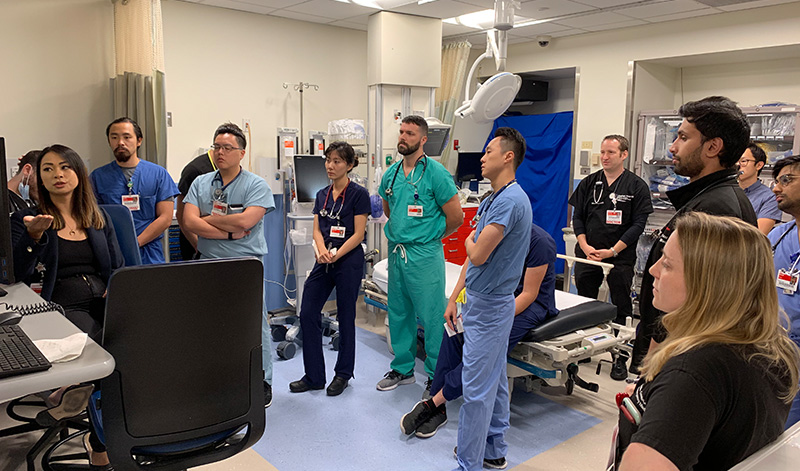Clinical Curriculum & Rotations

All Emergency Department resident shifts are a mix of 8 and 12 hours in duration shifts. There are three types of shifts:
- DAY (7:00 AM to 7:00 PM)
- DAY (7:00 AM to 3:00 PM)
- DAY (9:00 AM to 5:00 PM)
- SWING (11:00 AM to 11:00 PM)
- SWING (3:00 PM to 11:00 PM)
- SWING (5:00 PM to 1:00 AM)
- NIGHT (7:00 PM to 7:00 AM)
- NIGHT (11:00 PM to 7:00 AM)
Residents are scheduled for the following: PGY1 - 204 clinical hours in every 28-day emergency medicine block, equivalent to seventeen 12 hour shifts. PGY2 - 192 clinical hours, equivalent to sixteen 12 hour shifts. PGY3 - 180 clinical hours, equivalent to fifteen 12 hour shifts. PGY3/Chief - 168 clinical hours, equivalent to fourteen 12 hour shifts.
PGY-1
The template below outlines the clinical curriculum for the intern year. The focus is on obtaining a broad knowledge base and procedural skills necessary for Emergency Medicine. During clinical shifts, residents work either on a team with a senior PGY-3 resident plus an attending or directly with an attending. Additionally, there is an emphasis on achieving proficiency at common EM procedures such as intubations, central lines, and bedside ultrasound.
| Rotation | Number of 4-Week Blocks |
|---|---|
| Introduction to EM – Orientation | 1 |
| Emergency Medicine* | 5.5 |
| Pediatric Emergency Medicine | 2 |
| Anesthesia/Airway | 0.5 |
| Medical ICU | 1 |
| Obstetrics & Cardiothoracic Surgery | 0.5 |
| Ultrasound/Critical Care | 1 |
PGY-2
Residents in their second year are expected to work more independently within the ED, as part of a graded increase in responsibility. During clinical shifts, they work alongside an attending where they are responsible for an entire section of the ED or in the “trauma room” where they have primary responsibility for the most critically ill patients in the department. There is an emphasis on increased efficiency and autonomy. Off-service rotations offer comprehensive trauma and critical care experiences.
| Rotation | Number of 4-Week Blocks |
|---|---|
| Emergency Medicine* | 7 |
| Pediatric Emergency Medicine | 1 |
| Admin | 0.5 |
| Neurocritical Care | 0.5 |
| Surgical ICU | 1 |
| Ultrasound & Research | 1 |
| Neonatal ICU | 0.5 |
| Rapid Response Team/ICU Consults | 0.5 |
PGY-3
The goal of the third year is for residents to function as attending physicians within the ED. They continue to work “trauma room” shifts to gain additional exposure to critically ill patients. During clinical shifts, our seniors treat their own patients but also assume a teaching role by supervising junior residents. Many residents utilize the elective month for an international experience, research, or more focused clinic work in areas such as advanced emergency ultrasound, electrophysiology/cardiology, and radiology.
| Rotation | Number of 4-Week Blocks |
|---|---|
| Emergency Medicine* | 7.5 |
| Pediatric Emergency Medicine | 1 |
| Elective | 1 |
| Orthopedics | 0.5 |
| Toxicology** | 0.5 |
| Trauma/Critical Care | 1 |
| EMS*** | 0.5 |
| Research & Medical Education | 0.5 |
* Each EM block is interspersed with 2-3 pediatric EM shifts
** The toxicology rotation occurs at the New York City Poison Control Center (New York University)
*** Rotation is through FDNY



